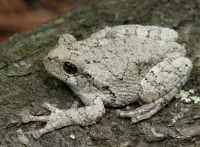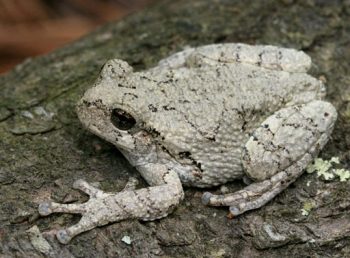Gray tree frog (Hyla versicolor) is a small-sized chameleon-like arboreal (movement of animals in trees) frog. It is a solitary and nocturnal species. The Europeans call this frog as the North American tree frog. Its scientific name means ‘variable color’.
The color of the frog varies because it can camouflage itself according to the color of the substrate (the surface where it lives). It changes its color from gray to green or from black to white depending on the temperature of the surroundings and the time. Its skin is full of lumps. Typically, the body is gray in color. A female frog has pale-colored throat while the color of the male frog’s throat can be gray or black during mating season. There are bright-yellow spots on the back of their legs. Tadpoles of these frogs are round-shaped and have broad tails.
In size, the male gray frogs are smaller than the females. The average length of these frogs range from 3.8 to 5.1 centimeters.
The average lifespan of the gray treefrog is 7 to 9 years.
For m ating, the male gray treefrogs usually makes loud calls that can continue for hours. Mating occurs in early spring. During one breeding season, the pair mates for three times. A young treefrog reaches maturity at the age of 2 years.
ating, the male gray treefrogs usually makes loud calls that can continue for hours. Mating occurs in early spring. During one breeding season, the pair mates for three times. A young treefrog reaches maturity at the age of 2 years.
A female treefrog lays a clutch size of around 1,000 to 2,000 eggs. The eggs are hatched after up to 1 week.
Gray treefrogs are widely distributed across the U.S. and Canada. In the eastern United States, they are found from Florida to Texas while in Canada, they are present in southeastern areas like Ontario and Quebec. They can put up with extremely low temperatures of -8 °C.
These frogs move around trees (arboreal) and so they are found in greenwood regions. Gray treefrogs usually stay high in the canopy (treetops) but often choose marshlands, pools and water gardens for breeding. Male treefrogs usually indulge in territorial fights with each other that may go on for 90 seconds.
These frogs prefer eating snails, mites, slugs and spiders. The other smaller frogs may also become part of their rare diet. By means of its toe pads, it can easily climb up the trees to feed on insects.
Other Names: Tetraploid gray treefrog, Common gray treefrog, Eastern gray treefrog





